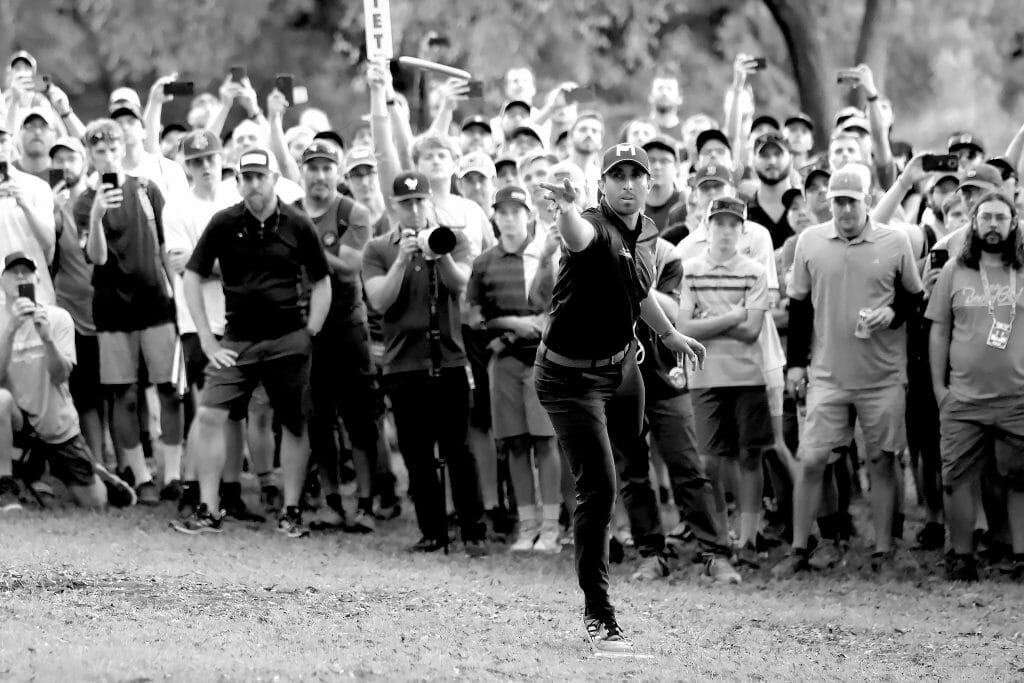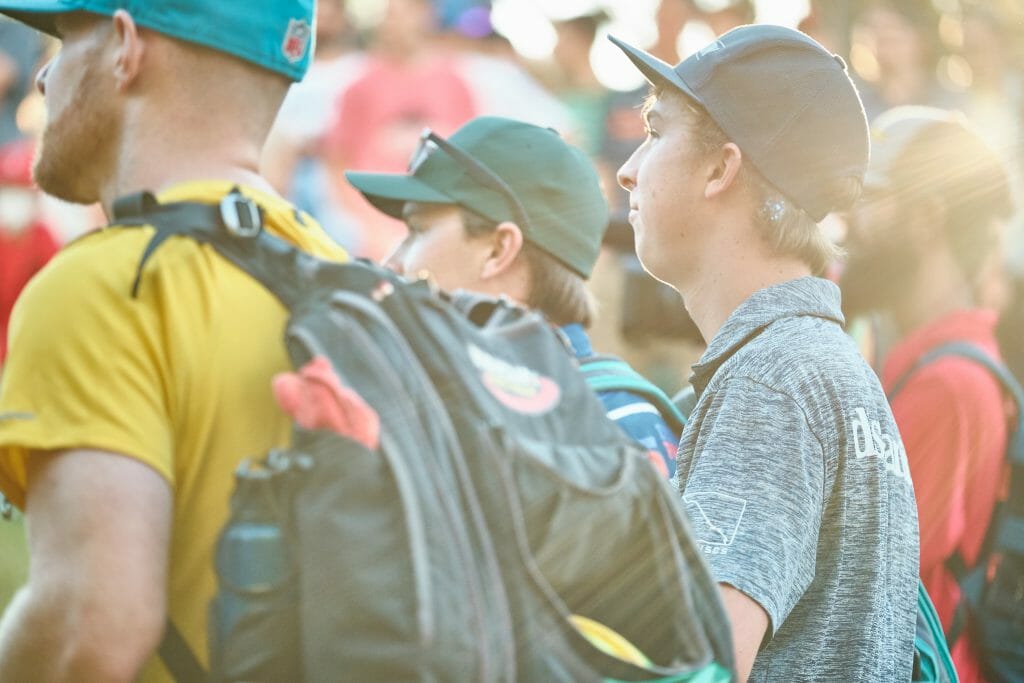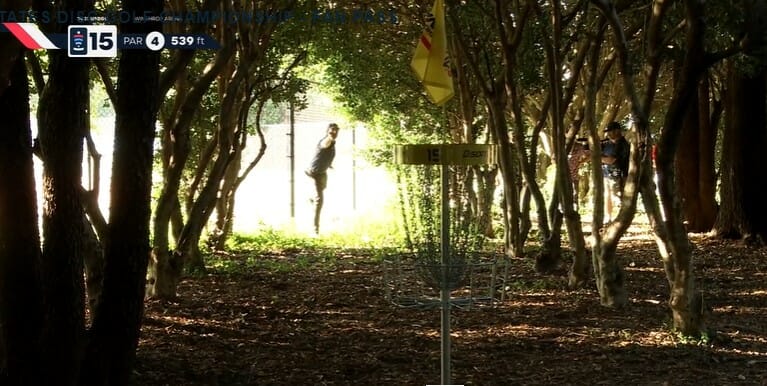Originally published at: https://discgolf.ultiworld.com/2021/10/11/paying-the-mental-toll/
 Paul McBeth at the 2021 USDGC. Photo: PDGA
Paul McBeth at the 2021 USDGC. Photo: PDGA
Ultiworld Disc Golf’s coverage of the 2021 United States Disc Golf Championship and Throw Pink Women’s Disc Golf Championship is presented by Skybreed Discs, a top online retailer and preferred vendor of the 2021 Ledgestone Insurance Open.
Write this down in case you ever need it: when facing a parole hearing, try to get a morning time slot. The psychological concept of decision fatigue tells us that our ability to make good decisions is finite. Even highly trained decision makers, like parole board judges, have been shown to be weary of hearing each case on its merits, often reverting to the default decision, which is to deny parole, by mid-afternoon. For the same reason, supermarkets arrange lots of sugary snacks at the checkout. People’s ability to resist temptation is lower when they’ve already made a bunch of other food related decisions.
Philo Brathwaite summed this up during the Disc Golf Network coverage of the Unites States Disc Golf Championship’s final round on Sunday.
“There are so many decisions to make out there on this course. Do you hold ‘em or do you fold ‘em? Do you lay up or do you go for it? It can wear you down.”
The research shows that the most mentally fatiguing decisions are as Philo describes – ones that involve a trade-off. Because it is designed to present this scenario over and again, I argue that Winthrop Gold is the most decision fatigue inducing course in disc golf. I was curious to view what transpired this weekend in Rock Hill through that lens, especially when we look at how Paul McBeth played the back nine. McBeth has won three USDGC titles, but he has fallen short 10 times, and in the years I’ve been watching him, it’s the far side of the Winthrop Coliseum, from where you leave the baseball stadium to when you join it again, that has been his undoing.
After taking a two-throw lead into the final round and shooting 3-down on holes 1-3, McBeth could not buy a birdie for the next six holes. Even if his caddie wasn’t checking UDisc, he would have known the chase card was on the rampage. The cheers were reverberating across the lake as Joel Freeman, Kyle Klein, and Ricky Wysocki started tearing it up. On hole 8, after narrowly avoiding the OB left, McBeth shaped a beautiful forehand flex shot down the narrow fairway to land at circle’s edge. The birdie putt hit the top band and McBeth’s shoulders slumped as he looked skyward in exasperation. He’d missed from a similar distance on hole 7 and his body language seemed to say, “when is one of these going to drop?”
The tee pad on hole 9 had been one of the slowest to lose its moisture from Friday’s rain. It had already caused one of the chase card, Ricky Wysocki, to interrupt his birdie streak with a front foot slip that caused a stall and early fade into OB. One hole behind, McBeth followed suit, looking down at his front foot as soon as he released, then back to a disc that was flying too high, too right, and too short. McBeth and Wysocki were the only players in the top 10 to bogey hole 9 and their reactions to the stumble could not have been more different.
Wysocki seemed to channel his anger into a powerful high, wide rip on hole 10 that flirted with the fence line on the right side of the fairway before fading into Circle 1 and an eagle putt. Joel Freeman did similar, making it two players from the chase card to eagle the hole. McBeth decided to lower the temperature, laying up and then dropping his upshot 15-feet from the basket for a stress-free birdie. He seemed to be making the choice to stay calm and preserve his mental energy for the cluster of four holes that some affectionately call “murderers row.” As on-course announcer Nate Perkins mentioned the day before, McBeth had been one of the few players to stay patient and stick to his routine in the rain. Despite the literal and figurative noise emanating from the chase card, it looked like he was following the same doctrine in the final round. McBeth may also have been influenced by seeing Drew Gibson, with his immense power, turn and burn into the headwind and go out of bounds. Gibson and Chris Dickerson both threw double-bogeys on this hole, taking themselves out of contention. It was Paul vs. the chase card from here on in.
 Kyle Klein at the 2021 USDGC. Photo: PDGA
Kyle Klein at the 2021 USDGC. Photo: PDGA
So, what’s the big deal with murderers row anyway? At face value, holes 10 through 14 look to be easier and wide open. They lack the water hazards, thick rough and guardian sticks (bamboo, chia, mozzarella and otherwise) of the front 9. They also don’t have the triple-mando clowns-mouth of 15, the hay bales and overall terror of 17, or the extreme challenge of 18. Yet it is this stretch of holes that has broken so many disc golfers who dream of wearing a championship ring.
One feature that might not be apparent when viewed from the broadcast, is the topography. The long stretch of lawn that follows Eden Terrace along the north side of the Coliseum is like a freshly mown moonscape. It has small craters, domes, ridges, and valleys that disrupt any airflow across its surface. There are inexplicable updrafts, downdrafts, and strange swirls that will pull a disc down or lift it into the hazard and OB areas. During the final round there was a stiff breeze blowing down its entire length.
Aside from the hedge that guards the right side of the fairway on 11, there is also a lack of distinct physical obstacles to sight your throw against. On murderers row, the course doesn’t choose for you. You must decide where you want the disc to land. In a major tournament with so much at stake, it forces decisions like nowhere else.
On hole 11, Dickerson’s choice to throw a roller into the strong cross wind, a choice that perplexed all commentators, was one example of the decisions this part of the course seems to induce. McBeth decided to chance the hazard area on the left of the fairway, fell short, but laid up for his par. The rest of the lead card scored between 1- and 3-over for hole. If it wasn’t apparent already, the chase card had become the lead card.
So far so good for McBeth though. Just hole 12 to play and there’d been no bleeding. After a perfect drive to the ideal position on top of the spine in the middle of the fairway, his approach fell short. He decided to try again from the drop zone and threw wide and short but inbounds. A 45-foot putt hit the cage and the double-bogey six dropped him one-throw behind both Wysocki and Klein, who were already over on tee-15. Some might have thought that murderers row had claimed McBeth again. But only one throw down, with two holes to make up, and back in the land where discs obey the laws of physics – he had his challengers right in front where he could see them. McBeth was staying patient. He’d left some skin on murderers row, but he was still alive in the tournament.
If it wasn’t for the shot of the century, we’d be all talking about Catrina Allen’s approach to basket 18 in this year’s world championships. We’d also be talking about some of the long putts that McBeth made in the final round of that tournament. For the 2021 USDGC, we’ll be talking about three towering putts McBeth made in the last five holes. After a controlled and perfectly executed birdie on hole 13, McBeth’s forehand tee shot sailed well past the circle on hole 14. He made the uphill putt to the elevated basket from the edge of OB, riding the disc home like he was hanging ten on the front of a surfboard. After throwing short of the triple-mando on 15, his scramble roller looked to have tracked way too wide and caught the fence to the north of the basket. Luckily the disc stopped adjacent to an avenue of small trees that led straight to the pin. The footage of McBeth, framed by the trees and in a shaft of late afternoon sun as he drained the long putt to save par, will be one of the iconic images of the tournament.
 Paul McBeth putting on hole 15 during the final round of the 2021 USDGC. Screenshot: DGN
Paul McBeth putting on hole 15 during the final round of the 2021 USDGC. Screenshot: DGN
Then, after a par on 16 and the long walk to the little grassy knoll near the shack that overlooks the lake, McBeth faced the infamous hole 17. If you played hole 17 it in a casual round and without the hay bales, you’d wonder what all the fuss was about. It’s a relatively simple 250-foot, slight left to right, downhill shot. But then put everything on the line, add a huge gallery, and use the hay bales to force a committed, high shot to the green, and 17 is a different story. The little tee pad with the lovely view of the lake framed by the trees has seen more tragedy and drama than anywhere else in disc golf.
There was a hiccup with the UDisc Live scoring that incorrectly showed Klein one throw back from McBeth as opposed to the one throw lead he correctly held. McBeth said he decided to play safe because he thought he may have a lead, and he changed his plan from previous rounds on this hole; choosing instead to throw an overstable Raptor, wide to the safe part of the green, rather than backhand a slower disc straight at the basket. With the entire gallery crowded around the hay bales and up on the hill watching, McBeth faced a 60-foot putt with a right to left crosswind waiting to lift a poorly angled throw over the hay bales and into OB. He set it aloft, high and to the right of the basket and watched it fade left grab the heart of the chains with the roar of the crowd sending it home.
Klein had played hole 17 similarly, deciding to throw a high, wide forehand to the fat part of the green. He hadn’t made the birdie putt however and, already in the clubhouse with a par on hole 18, he knew that McBeth only had to par the final hole to force a playoff.
On 18, McBeth threw a putter off the tee and saw the wind push it down closer to the water than his nerves would have liked. Yet the disc made dry land and slid just in-bounds on the low part of the fairway. Here it was decision time again: lay-up high and wide and play for par? Or go aggressive with a fast disc and aim to skip back down the hill to create a birdie chance? McBeth pulled a Zeus from his bag which signaled that he was going for it. The shot was just a fraction low, caught some longer grass on the first skip and got dragged to a halt 40 feet short of the basket. Still unsure of his position relative to Klein, McBeth chose the death putt over playing safe. It was another towering effort that grabbed a lot of chain but was just on the wrong side of the basket. Thankfully the disc stayed high on the bank and dry. He tapped in to force the playoff.
There was no decision to be made on hole 1 of the playoff. The task was to throw straight and clear the rocks. McBeth did, with an ace run that made the crowd roar, and Klein didn’t. Klein pitched out from the bushes on the left off one knee and missed. There’s a YouTube video of McBeth making 50 putts in a row from the same 30-foot distance he had to claim the United States Disc Golf Championship. The huge gallery started to roar almost as soon as the disc left his hand. They knew it was going in. It’s been a frustrating year on the course for disc golf’s biggest name. Winning his third USDGC would have soothed much of that frustration. He was patient, he waited for his chance, and when that chance came at the last moment, he took it.
The rest of the field gets to go away, reload, make plans, and try again next year as the cycle of qualifying and preparing begins all over again. Most will know that, in Winthrop in October, you can’t just bring your physical skills and expect to triumph. You must come prepared for the most psychologically demanding course on the tour.
